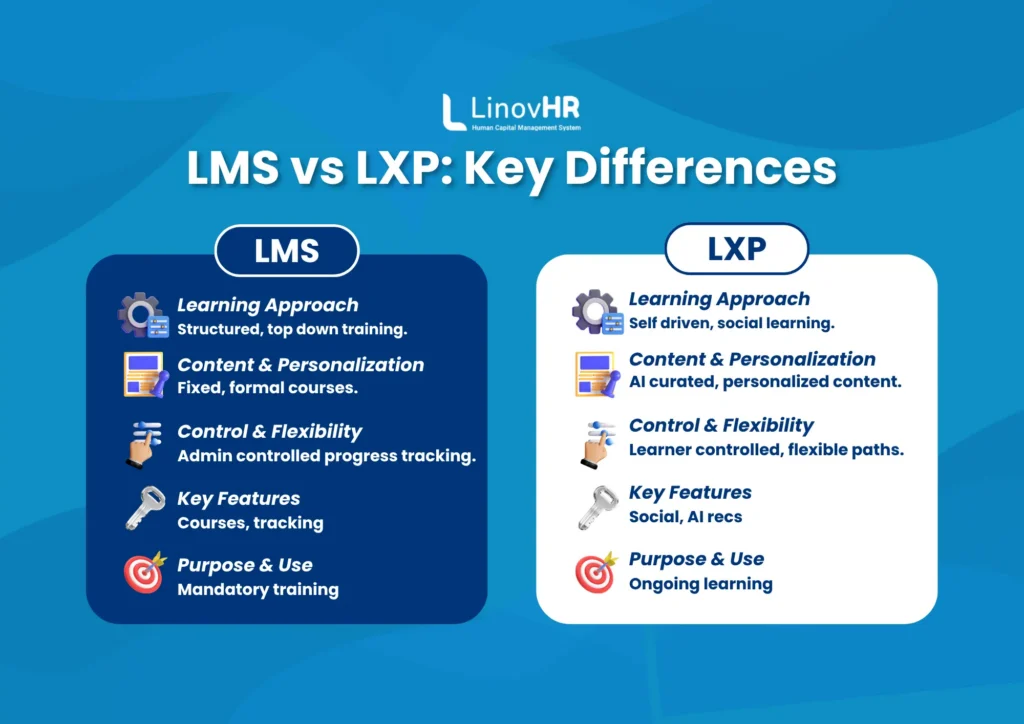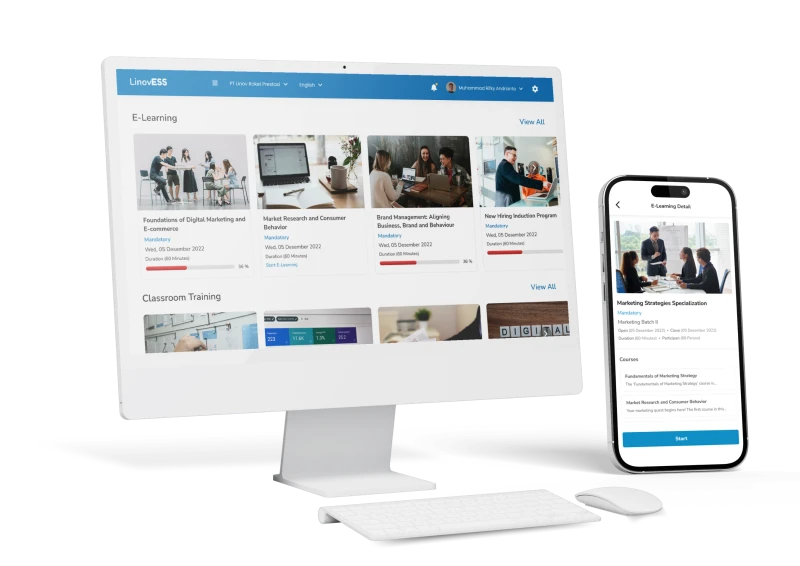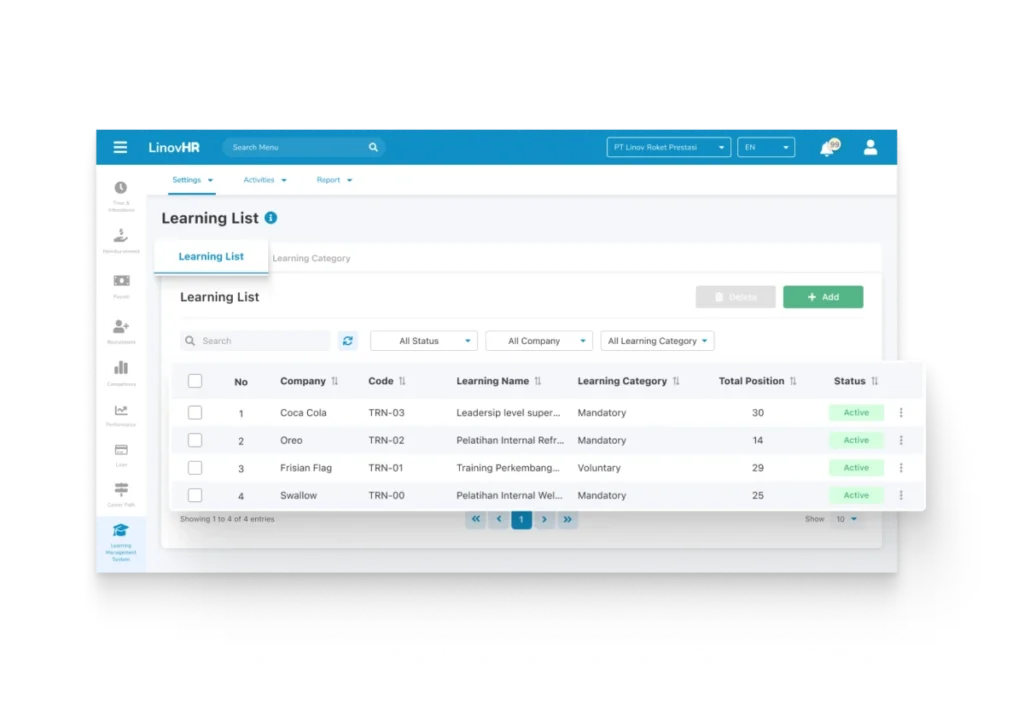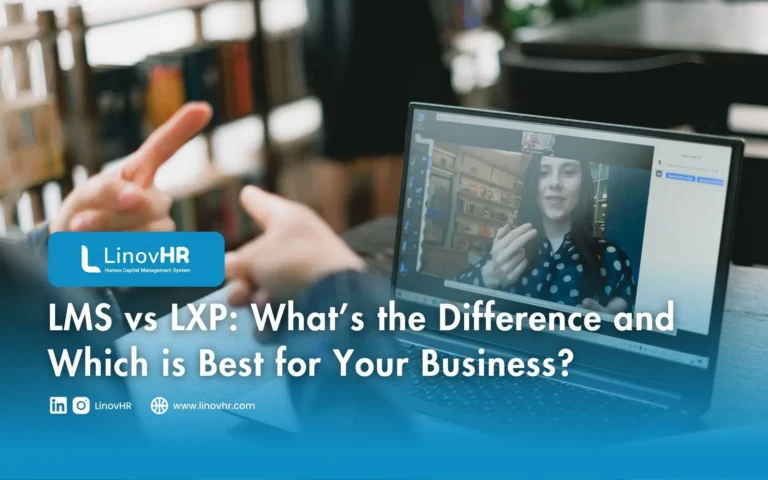In today’s fast evolving digital learning landscape, organizations are increasingly relying on technology to train and upskill their employees.
Two of the most popular platforms in this space are the Learning Management System (LMS) and the Learning Experience Platform (LXP).
While both are designed to support learning and development (L&D) initiatives, they serve different purposes and offer distinct user experiences.
Understanding the differences between LMS vs LXP will help HR leaders select the right solution that balances structure, engagement, and long-term learning outcomes.
This article explores how each system works, their main features, and the benefits they bring to employee learning, helping you make an informed decision that aligns with your organization’s needs.
What is an LMS (Learning Management System)?
A Learning Management System (LMS) is a digital platform designed to manage, deliver, and track employee training programs within an organization.
It serves as a centralized hub where HR or L&D teams can store course materials, assign learning paths, and monitor employee progress.
Typically, an LMS is used for structured and compliance-based training, ensuring that employees complete required courses within specific deadlines.
In most companies, the content available in an LMS is created by internal instructional designers or purchased from third-party vendors.
Learning experiences in an LMS often follow a top-down approach, where instructors deliver formal training to learners.
Key features of an LMS usually include:
- Course creation and management tools.
- The ability to assign and track course completion.
- Automated reminders to keep learners on schedule.
- Dashboards and analytics for monitoring learning progress.
- Feedback tools to evaluate course effectiveness.
Also read: 10 Best Learning Management System (LMS) Software for 2025
What Is an LXP (Learning Experience Platform)?
A Learning Experience Platform (LXP) is a modern learning solution that focuses on delivering personalized and engaging learning experiences for employees.
Unlike a traditional LMS that provides top down, structured training, an LXP promotes self directed learning by allowing users to explore, share, and recommend content that matches their individual interests and career goals.
LXPs often leverage AI and machine learning to recommend relevant courses or resources, helping employees continuously develop their skills.
They can also integrate with existing LMS systems, creating a seamless blend between formal training and informal, experience driven learning, a key difference highlighted in the LMS vs LXP comparison.
Common features of an LXP include:
- AI powered content recommendations.
- Integration with existing LMS platforms.
- Tools for adding and sharing videos, articles, or external resources.
- Social learning capabilities like following peers and commenting.
- Personalized learning paths based on employee roles and skills.
LMS vs LXP: Key Differences You Should Know

Although both LMS and LXP serve the purpose of employee learning and development, their approach and functionality differ significantly.
Understanding these LMS vs LXP differences can help organizations choose the right solution for their workforce.
Focus and Learning Approach
An LMS focuses on structured, top-down training controlled by management and L&D teams. Learning is typically mandatory and compliance-driven.
Meanwhile, an LXP promotes learner autonomy, encouraging employees to explore, share, and engage in self-paced, social, and collaborative learning experiences.
Content and Personalization
In an LMS, content is often pre-defined and limited to formal courses, such as compliance or onboarding programs.
LXPs, on the other hand, emphasize personalized learning by curating microlearning modules, videos, and articles based on employee interests and career goals through AI-powered recommendations.
Control and Flexibility
An LMS offers centralized control, where administrators assign courses and track progress.
In contrast, an LXP empowers employees to take charge of their learning journey, offering flexibility and adaptive pathways that evolve with user engagement and skill development.
Key Features
Common LMS features include course creation, progress tracking, and compliance management.
LXPs focus more on user experience, social learning tools, content recommendations, and integration with third-party platforms, blending formal and informal learning.
Purpose and Use Cases
Ultimately, LMS vs LXP can be viewed as structure vs experience. LMSs are ideal for mandatory training and certifications, while LXPs excel in continuous learning, engagement, and upskilling initiatives.
Many modern organizations use both systems together to achieve a balanced, holistic learning ecosystem.
While both LMS and LXP aim to enhance employee learning, they differ significantly in purpose, structure, and user experience.
The table below highlights the key distinctions between these two learning systems to help you determine which one better fits your organization’s needs.
| Aspect | LMS | LXP |
| Focus | Top down, compliance-driven learning managed by L&D teams. | Learner driven, focused on engagement and continuous learning. |
| Content Type | Structured courses such as compliance or onboarding training. | Diverse and personalized content including videos, articles, and microlearning. |
| Control | Admins assign and track mandatory courses. | Employees choose and explore learning paths autonomously. |
| Key Features | Course creation, tracking, reporting, and certification. | AI recommendations, social learning, and content curation. |
| Learning Experience | Formal and instructor led. | Interactive, collaborative, and experience based. |
Also read: 12 Best Employee Training Software for 2025
Pros and Cons of LMS and LXP
When comparing LMS vs LXP, it’s essential to understand that each platform offers unique strengths and limitations depending on your organization’s training goals.
An LMS provides structure and control, while an LXP focuses on personalization and engagement. Below are the key pros and cons of both systems:
Learning Management System (LMS)
Pros:
- Provides structured learning paths and centralized course management
- Offers robust compliance tracking, reporting, and certification features
- Ensures consistent training delivery across the organization
Cons:
- Limited social or collaborative learning features
- Rigid and admin focused interface
- Less flexibility for user driven learning experiences
Learning Experience Platform (LXP)
Pros:
- Delivers personalized, AI driven learning recommendations
- Encourages collaboration and social learning among employees
- Supports user generated content and flexible content discovery
Cons:
- Lacks structured paths for compliance based training
- Can lead to content overload or inconsistent learning outcomes
- Requires high user engagement and may come with higher subscription costs
LMS vs LXP: Which One Should Your Business Choose?
Choosing between LMS vs LXP depends on your organization’s size, learning objectives, and industry needs.
Both systems serve different purposes: an LMS focuses on structured, compliance driven training, while an LXP emphasizes flexibility, personalization, and engagement.
For small businesses, an LMS is often the best starting point. It provides an affordable way to manage essential and compliance training efficiently.
However, startups or high tech companies that value self directed learning and collaboration may find an LXP more effective for fostering a culture of continuous learning.
Midsize to large enterprises, especially those in highly regulated industries, benefit more from an LMS due to its advanced tracking, reporting, and configuration capabilities.
Yet, organizations prioritizing innovation and employee engagement might consider integrating both systems to get the best of both worlds.
Some vendors now offer hybrid or combined solutions that merge LMS and LXP functionalities into one unified platform.
These options can provide comprehensive learning management and engaging user experiences without requiring two separate systems.
Ultimately, the right choice between LMS vs LXP depends on your business priorities, workforce size, and learning culture.
Evaluate your training goals and scalability needs to select a system that drives performance, compliance, and long term skill growth.
How LinovHR Helps Businesses Get the Best of Both LMS and LXP Worlds

In the ongoing debate between LMS and LXP, LinovHR emerges as an integrated learning solution that combines the best of both worlds.
Designed to meet the needs of modern organizations, LinovHR’s LMS combines powerful management tools with user friendly features that empower both administrators and employees to learn efficiently and effectively.
With LinovHR, companies can create and manage customized training programs, monitor employee progress in real time, and issue automatic e-certificates upon course completion.

The platform supports both online and offline training, ensuring flexibility through blended learning formats accessible via web and mobile.
Key Features of LinovHR LMS
- Comprehensive Training Management: Plan and organize learning topics, instructors, materials, and schedules in one integrated platform.
- Personalized Learning Paths: Provide tailored courses that align with employee roles, career goals, and development needs.
- Blended Learning Support: Combine classroom and e-learning experiences with seamless tracking and automated attendance via QR integration.
- Smart Monitoring Tools: Access detailed reports, training analytics, and reminders to ensure no learner falls behind.
- Employee Driven Learning: Encourage employees to request training, suggest new topics, and take control of their learning journey.
- Automatic Certification: Generate digital certificates instantly once employees complete their training programs.
Why Businesses Choose LinovHR
LinovHR helps companies digitize and streamline every aspect of employee development.
Its intuitive interface, automation capabilities, and flexibility make it the ideal LMS solution for businesses that want to improve employee performance, reduce administrative workload, and foster a continuous learning culture.
Ready to empower your workforce with smarter learning technology?
Request a free demo today and see how LinovHR transforms your employee learning experience






